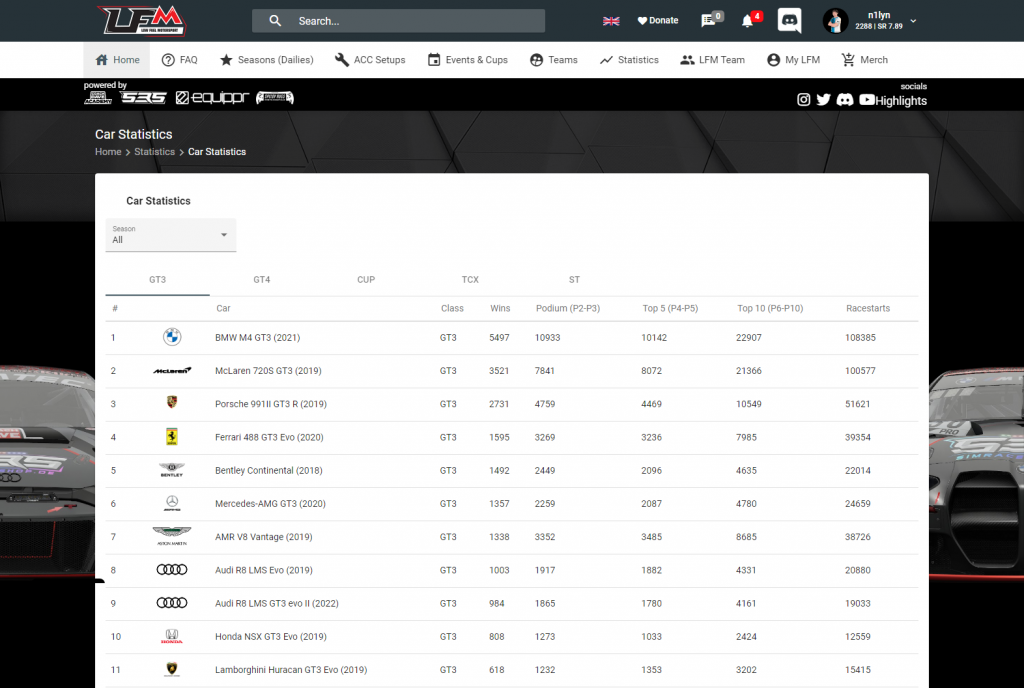Fuelled by Passion.
One of the great strengths of iRacing is that you can go online any time of day, anywhere in the world and you will always find a race that is about to commence. No need to follow forums, no need to engage with any type of administrative process to be able to take part. Just hit ‘join’ and wait for the session to go live.
The lack of such a simple procedure has been one of the weakest points of Assetto Corsa Competizione for players interested in easy to use matchmaking with an underlying ranking system that ensures you are surrounded by players of similar driving capacities. This comes in addition to one of Esports Racing’s inherent flaws, too much variety and too little structure.
There are simply too many games, organisers, events, classes and cars. While there is a big community playing racing simulations, there are often not enough players to actually fill a grid of a given league, at a certain day, with a certain class of cars.

It was in late 2020 that Boris had enough of the existing solutions on the platform. Some were good attempts, but ultimately lacked to deliver the full experience known from iRacing or involved working through excel tables – not really the automated system that existed on the greener side of the fence. He has played iRacing since 2009 and therefore had a very clear picture of how their system worked and that served as the base for what he was trying to create for ACC.
Unaware and regardless of whether it would work and if players actually wanted such a system, he spent the last four months of 2020 adding another eight hours of programming every night to his main job. By December 28th he had a first functioning version of a daily racing system, with servers automatically starting and registering players at certain times of day. It didn’t take long to notice that there indeed was a desire in the community for such a system. The users grew steadily and when streamers picked it up it resulted in a large influx of new players. After just one year 20,000 people registered. Half a year later, the number doubled to 40,000.
Yet, until this point it was a steady climb behind the curtain as well. The work on the platform was far from over. In the beginning there was only a rating system for the drivers to be able to sort them into grids. A safety rating nudging people to drive more cleanly took some more time to implement. They played around with various formulas before they found an outcome they were happy with. The game only provides car contact logging and its severity but there’s no separation between cause and effect. The rating now also respects the amounts of corners that were driven cleanly to calculate a number that players would either gain or lose towards their safety rating. That again is now used to become eligible for certain series on the platform of which there are now running several different ones.
While those ratings are a good incentive to nudge drivers to race carefully, it remains inevitable in racing that there will be contact. A total of 30 volunteers are helping to review and judge about 100 reported incidents per day in order to hand out penalties to further sanction reckless driving (for the sake of science the author went to test the system and rightfully received a penalty shortly after for not holding the brakes when he got spun on track).
Another 26 people are working behind the scenes organising races, running streams and social media accounts – also all voluntarily. Given how large the platform has become, also the time that the staff invests has grown. Therefore, even if it’s currently not yet feasible, Boris indeed has plans to monetise the whole project – also to give back to everyone who has been contributing to its success.
At the time of writing, LFM season 7 is around the corner, again lasting 12 weeks during which the same track is driven in scheduled races – depending on the series – every hour for one week. The best result for each driver will count towards the season standings and eventually, there will be a winner in each series. Additionally, there is now a series aimed at the fastest drivers on the game with a broadcast happening each Wednesday.
In the future, Boris tells me, they want to see if it makes sense to extend the platform to other games, now that the framework exists, but for the time being he’d be happy if all the existing features in Assetto Corsa Competizione were developed further to make the game even more enjoyable – and to make it easier for third parties to work with it by having better and direct access to the server to feed the website for example. While he’s at it, Boris mentioned other things on his wish list: “I’d of course love more tracks like the Nordschleife or cars like TCR – but at the same time this would also go against the idea of reducing the variety a bit to be able to fill the grids”.
Low Fuel Motorsports has achieved what others tried before them. They managed to gather a huge part of the active player base and offer them something they needed to enjoy the game on a regular basis without the need to do any administrative work as a player.
“All this is only possible because of the incredible work of everyone behind the scenes. I’m just endlessly thankful for everyone who is dedicating their time to LFM!”.
Virtual racing does not need fuel to happen, but its existence and success is fuelled by passionate people like Boris and the entire team behind Low Fuel Motorsports.
Nils Naujoks
Image Credits: Low Fuel Motorsports
